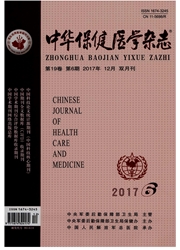

 中文摘要:
中文摘要:
目的探讨、分析老年肾病综合征(NS)的临床与肾病理特点。方法回顾性分析2008年1月~2010年12月某院〉60岁120例老年NS患者的临床表现和肾活检病理诊断类型及其之间的关系。结果男性75例,女性45例,平均年龄(69.9±5.1)岁。120例NS患者中合并肾炎综合征有56例(46.7%),合并的其他主要疾病有高血压(50例)、慢性肾病(34例)、2型糖尿病(23例)、冠心病(19例)、急性肾损伤(10例)。肾活检病理诊断中膜性肾病62例(51.7%);其余分别为局灶节段性肾小球硬化症11例、系膜增殖性肾炎9例、IgA肾病8例、微小病变7例、糖尿病肾病5例、糖尿病肾病合并膜性肾病2例、淀粉样变肾病3例、紫癜性肾炎3例、肾小球轻微病变2例、ANCA相关性肾炎2例、多发性骨髓瘤肾损害、慢性间质性肾炎、狼疮性肾炎各1例。结论老年人发生NS临床表现与年轻患者显著不同,老年NS的病理改变仍以膜性肾病为主,存在多种继发因素。
 英文摘要:
英文摘要:
Objective To analyze the Clinical and histopathologic characters of nephrotic syndrome in old patients.Methods We collected 120 nephrotic syndrome patients older than 60 years old,who were hospitalized from January 2008 to December,2010 in PLA general hospital.Then clinical and histopathologic characters of these patients were analyzed and found the potential relation ships.Results The study group consisted 75 male and 45 female patients,the average ages was 69.9±5.1 years.The complicating diseases included nephritis syndrome(n=56,46.7%),hypertension,chronic kidney disease,noninsulin-dependent diabetes mellitus,coronary artery disease,acute kidney injury.Membranous nephropathy(MN,n=62,56.7%) was the most common histopathologic finding of renal biopsy,followed by focal segmental glomerulosclerosis(FSGS),mesangial proliferative glomerulonephritis(MsPGN)、IgA nephropathy(gAN),minimal change nephropathy(MCN),diabetic nephropathy(DN),purpura nephritis,Amyloid nephropathy,DN with MN,mesangioproliferative glomerulonephritis(MPGN),ANCA associated nephritis,Myeloma kidney disease,chronic interstitial nephritis(CNI),lupus nephritis(LN),crescentic glomerulonephritis.Conclusions Distinguished significantly from young patients,the old NS patients were combined with several other diseases,which made the treatment more difficult.And the intensive therapies of basic diseases were very important for better outcomes of NS.The most renal histopathologic changes of old NS patients was membranous nephropathy,and the secondary causes should be excluded.The old NS patients should be given renal biopsy to find renal histopathologic changes for special therapies if there no special countraindications.
 同期刊论文项目
同期刊论文项目
 同项目期刊论文
同项目期刊论文
 期刊信息
期刊信息
